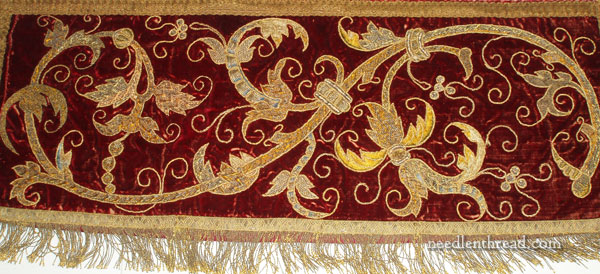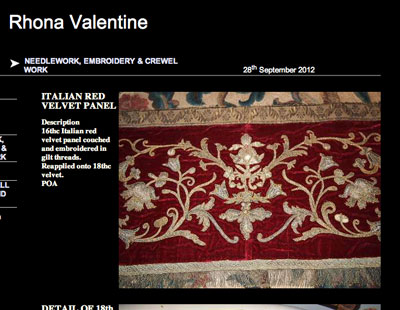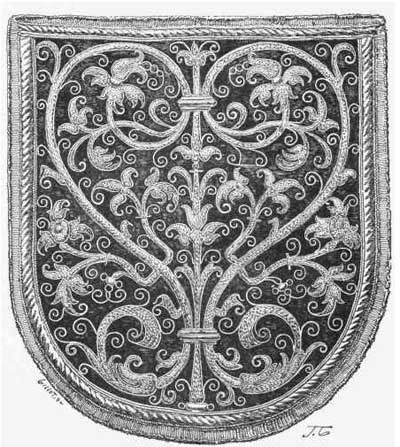This antique goldwork panel has me completely enchanted, if you hadn’t guessed by the inordinate amount of exploratory articles devoted to it!
Besides learning about the piece itself and the techniques involved to create the panel, I do have an ulterior motive in the study of it. More than likely, I’ll develop a project based on it. I like embroidery projects that are spin-offs of something I’ve learned about. And this goldwork panel appeals to me so much, that I think a spin-off project is an absolute necessity.

One subject that I haven’t talked about in depth is the age of the piece, so today, I’ll explore that topic a bit.
But you see, I’m no antiques expert, so I find it very difficult to claim with certainty any specific time frame for a piece of embroidery. The only thing I can do to determine a “maybe” about the age of an old piece of embroidery is guess, but I like my guessing to be based on at least some evidence that can justify my guess.
So I’m going to go out on a limb and say that the goldwork panel I have is most likely a piece of 16th century embroidery. This boggles my mind, of course. The 16th century was 500 years ago! That’s a lot of history!
I’m basing the 16th century hypothesis on a few things.

You’ll see a very similar Italian Red Velvet Panel available at Rhona Valentine. The description given is a “16th century Italian red velvet panel couched and embroidered in gilt threads. Reapplied onto 18th century velvet.” Finding experts that offer a similar piece is always helpful in determining a date.
Unlike the Rhona Valentine panel, the panel I have shows no evidence of being reapplied to the velvet ground. The stitches on the back of the layers of fabric are the actual embroidery stitches, not appliqué stitches used to fix the embroidery. I can’t tell a lot from the Rhona Valentine photo, but the velvet in that photo looks a little heavier or more lush than the velvet ground on my piece, which is somewhat thin and delicate.

Then there’s the red velvet hunting hood in Jacquemart’s History of Furniture (part 5) (the book is available online – just follow that link). The hood is 16th century, though French, not Italian. The arabesques are a bit more elaborate on the hood, but the whole design style is similar, and so are the techniques used (you can see the various couching techniques, especially in the lower half of the hood).
Here’s a bit on the difficulty of placing this type of embroidery into a precise moment in history, according to Jacquemart:
But a real difficulty is felt in establishing some tangible line of demarcation between the products of the close of the sixteenth, and the opening of the following century. In the first of these epochs, Italy was entering on its period of decline, while France was still animated by the full spirit of the Renaissance. It is at all events certain, that the reign of Louis XIII. was a glorious era for French embroidery. Not only was the fashion continued of producing figures in portraits in needlework, as in the previous century, but a fresh development was given to floral and arabesque ornament.
The hood is an example of that fresh development of arabesque ornament.
I think the similarity in the style (between the hood and my panel) helps justify placing the two pieces close together in history.
Some other justifications in dating the piece as far back as the 16th century: the materials in the panel were the pinnacle of Renaissance fashion. Among the upper classes (and the wealthy merchant class, especially in Italy) that could afford silk velvet and gold threads, they were the height of fashion. Also, the couching techniques in the piece are typical of Renaissance era embroidery with gold threads. Finally, there’s the design, with the arabesques and flourishes. This is very typical of Italian, Spanish, and French Renaissance art.
Now, I don’t know about you, but I have hard time getting my poor brain around the idea that this piece of embroidery may have been made some 500 years ago, and it’s sitting on top of a plastic table in my workroom, covered with a piece of cheap cotton fabric. If it could speak, what could it tell us about its history? About the people who owned it? The places its been? What conversations has it overheard?
On the other hand, it could’ve been shut up in a trunk for 500 years – in which case, I suppose the plastic table and the cheap cotton cloth are a welcome relief!
If you’d like to read previous articles about this goldwork & velvet embroidered panel, you’ll find them through the links below:
Old Goldwork on Velvet – Any Questions?
Old Goldwork on Velvet – Behind the Embroidery
Old Goldwork on Velvet – Some Finishing Touches
Old Goldwork Techniques Close Up
Further Explorations of Old Goldwork







You are so right, Mary. I do so wish these pieces could talk about where they have been and what they have seen! A piece that has lasted 500 years most assuredly has been tucked away in a trunk (or some sort of storage) for a very long time. I doubt it would have remained intact otherwise. What a treasure!!
Mary,
I have read your articles on this piece with great interest, but always assumed the piece was Victorian. What an honour to hold a piece of such great age! I am stunned. Your photographs and articles are giving it new life.
Dear Mary
How exciting to have a piece of embroidery that dates back maybe 500 years. I have a degree in history and like you I am interested in all forms of historical memorabilia and antiques, how interesting to have and own a piece of beautiful embroidery from the past. Yes! what could this antique piece of embroidery tell us about the people and places it has been part of!!!
Regards Anita Simmance
Another thing to consider if you have no information on the provenance of such a piece is whether there was ever a revival of that style.
If there was, you would need to be able to defend why you think your piece deserves to be dated to the original time period, instead of to a later period when the style and/or technique again became popular.
I love the intrigue of historic embroidery…. Thinking about the growers of fiber, those that prepared the raw fiber and transported it to the hand spinners, the weavers, the dyers, and then to the embroider who executed his skills in silk and gold. Silk from the far east that traveled by tall heavily sailed ships and gold dug from the earth, smelted and made into fine wires.
You have to wonder how many hands contributed their skills to this piece of work before it landed on your work table in Kansas. Fun things to think about!
I love silk and metal!!! Right now I am working on Spring Splendor, the EGA correspondence course. I would love to see the piece you design from this. But, where will you use your design? It doesn’t seem to have the composition for framing.
Interesting article, Mary. I think if you date this textile much more, you’re going to have to propose to it, though! 😉
LOL!
I was wondering how to bring that side of it in Jen. Good one. Kath.
This piece is truly fascinating. Every since you first showed it, the piece has reminded me of the “flower” used at one point in time to adorn the back of chasubles. Your photo of the hood above also looks very similar to those earlier pieces of the “flower.”
Hinda Hands shows examples of the “flower” in her book on pages 61 and 62. Anastasia Dolby has some beautiful illustrations in her book Church Vestments here: http://books.google.com/books?id=qeZLhbzW3AUC&printsec=frontcover&dq=church+vestments+anastasia+dolby&source=bl&ots=V1MPbboplX&sig=gmy-lF9yZfacniW3erhFAY8Z86M&hl=en&sa=X&ei=TNNlUObzOcf1ygGV9oCAAQ&ved=0CDYQ6AEwAA#v=onepage&q=church%20vestments%20anastasia%20dolby&f=false
In Anastasia Dolby’s book, plate 7 following page 53 shows the “flower” on St. Thomas’ Chasuble, and plate 16 following page 74 shows other beautiful flower illustrations. Anastasia also mentions that the velvets in church embroidery were Northern Italian, 15th century, not English work based on pieces she had seen at the South Kensington Museum. Perhaps, with the Reformation, as this type of work was no longer being done for the church, it progressed into the use for decorative use for the home.
We’ll be waiting for your design and project that comes from this! Thanks for sharing a fascinating bit of history with us.
This type of work still continued to be done for the church, during and after the Reformation. In fact, church embroidery continued to progress in “decorative effect,” following with the Baroque era, beginning around 1600 and going forward, especially in Italy, France, and Spain. This style we’re looking at here is the beginning or transition into Baroque, really…
Okay…let’s say it really IS 16th c. (even without a clear provenance – there’s no reason not to right now, and lots of reasons for)- and it is sitting on your work table…-it is an extremely valuable and rare survivor…I just have to ask – is there any special treatment it needs for conservation? Also, there may be some value in bringing in a museum specialist to see it – they might be able to pin down (no pun intended) a technique or the presence of a particular material that could narrow the field of possibilities. No matter what – it’s gorgeous and there is NO WAY you could spend too much time on it’s presentation and analysis!!!
How incredible to have the opportunity to study and learn from this beautiful piece! Thanks for sharing it with us, and all the details. I have always wanted to work on a Master’s Degree in Textiles and Fiber studies. I currently have a degree in Family & Consumer Sciences and have longed to go further into a specialized area. I’ve always felt the historical background of every piece of Fiber Art created is a potential story. The possibilties are so interesting! How far are you from Lincoln, Nebraska? The University of Nebraska at Lincoln offers a degree in Quilt studies and houses one of the largest collections of Fiber Arts items in the world. It might be worth contacting someone in their department who might assist you in furthering your research into this piece. Good luck and please continue to share what you discover.
As an art historian, I think your analysis to date has been excellent. There are two things that seem to have been unavailable to you so far: 1) credible reference material that would allow you to pin down (sorry, I picked it up too) specific methods or materials to particular periods, so you might want to contact the V&A or some other scholarly museum where there may have been research conducted on the subject; and 2) the possibility of scientific testing of the materials, which could determine their age, and place of origin.
As it is, I find yours a masterful analysis with practical insights in this wonderful mystery! Keep on digging!
G’day there Mary,
I’ve only just got to reading all this post and comments. It all arouses impressive and awe-inspiring thoughts. Fantastic.
Cheers, Kath
I was just thinking along the same lines as Elizabeth and Jo… thinking it might be fun to find out what light a museum curator/fabric conservator would shed on the piece.
Mary, in the 16th century there were a great many pattern books for embroidery and lace produced throughout Europe. These became the basis for much of the embroidery in the following years and are still heavily used today in embroidery, lace and weaving. What I’m saying is the pattern could be 16th century but the embroidery later. It is entirely possible that if it was well-preserved, your piece could be 500 years old but extant pieces are difficult to come by from that period as the gold was often “recycled” for other pieces. Do you have a local museum with a textiles expert? They would know how best to help you date your piece. Keep us posted, it is beautiful!
That History of Furniture book is great, isn’t it? I love the parts on raised/stumpwork and the hunting hood pattern you have above….
Hi Mary
I have been in love with the image of the red velvet hood for a couple of years. This spring I found a goldwork course, and now I’m working on it. I love doing goldwork and I love reading your blog!
I have a piece of very old embroidery artwork. It has a tag says was restored back in I would guess 1940s.
Can you tell me where I might go to find someone who might know something about this.